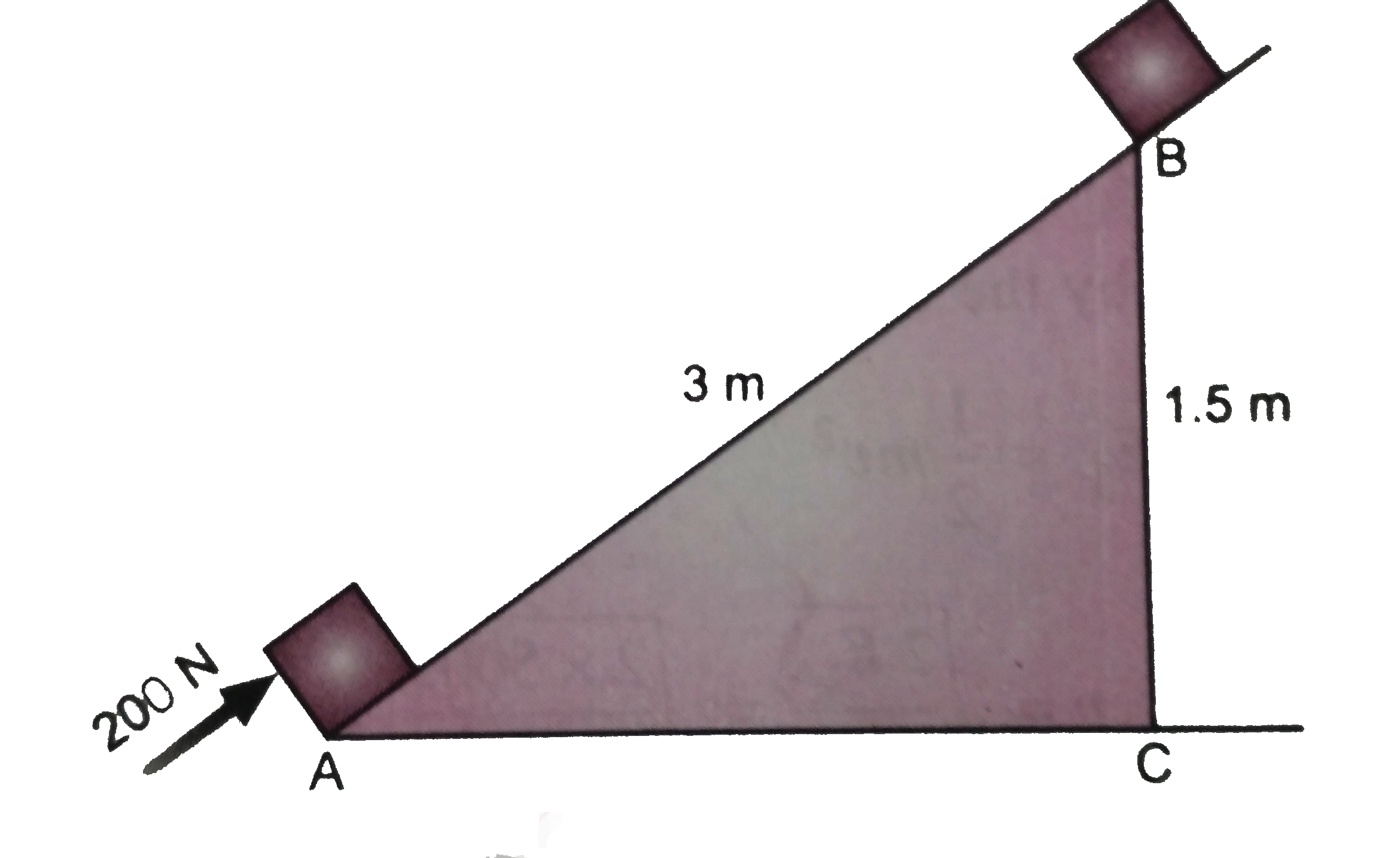A block of 20kg mass is pulled up a slope by applying a force equal to its weight parallel to the slope. If the slope makes an angle of 30∘ with the horizontal, calculate the work done in pulling the load up a distance of 3.0m. What is the increase in potential energ of the blocks? Assume that the force of friction is zero. Take g=10Nkg−1.
Here, mass m=20kg

g=10Nkg−1 Distance, d=3.0m Angle =30∘ To calculate
(i) Work done (W)=?
(ii) Increase in P.E=?
(i) W=Fd= mgd W=mgd=20×10×3=600J
From the figure h3=sin30∘orh=3sin30∘
=3×12=32m(∵sin30∘=12)
(ii) P.E =mg×h
Now, substituting this value of h, m and g we get,
P.E=20×10×32
P.E=300J
Since initial P.E (at the ground) is zero, increases in P.E =300J
Topper's Solved these Questions
- WORK AND ENERGYBOOK - MTG IIT JEE FOUNDATIONCHAPTER - WORK AND ENERGYEXERCISE - Exercise (Integer/Numerical Value Type)
5 Videos
- WORK AND ENERGYBOOK - MTG IIT JEE FOUNDATIONCHAPTER - WORK AND ENERGYEXERCISE - Olympaid/HOTS Corner
20 Videos
- WORK AND ENERGYBOOK - MTG IIT JEE FOUNDATIONCHAPTER - WORK AND ENERGYEXERCISE - Exercise (Subjective Problems short Answer Type)
16 Videos
- THRUST AND PRESSUREBOOK - MTG IIT JEE FOUNDATIONCHAPTER - THRUST AND PRESSUREEXERCISE - Olympiad/HOTS Corner
15 Videos
Similar Questions
A person pushes a block of mass 4 kg up a frictionless inclined plane 10 m long and that makes an angle of 30∘ with the horizontal . Then the work done is
View SolutionA man pulls a box on a horizontal floor through a distance of 20 m with a force of 30 N applied along a rope tied to the box and making and angle of 60° with the horizontal. Calculate the work done.
View Solution
Knowledge Check
A person pushes a block of mass 4 kg up a frictionless inclined plane 10 m long and that makes an angle of 30∘ with the horizontal . Then the work done is
A33.5JB−392JC339.4JD−196JA car weighing 100kg is on a slope that makes and angle 30∘ with the horizontal. The component of car's weight parallel to the slope is (g=10ms−2)
A500NB1000NC15,000ND20,000NThe work done in pulling up a block of wood weighing 200N for length of 10 m on a smooth plane inclined at an angle of 30∘ with the horizontal is
A18 KJB20 KJC10 KJDNone
A block of mass 30 kg is pulled up a slope as shown in with constant speed by applying a force of 200 N parallel to the slope from the initial position A to the position B,
(a)Calculate :
(i)the work done by force in moving the block from A to B, and
(ii)The potential energy gained by the block Take, g=10 m s−2
(b)Account for the difference in answers to parts (i) and (ii)

View SolutionA block of mass 30 kg is pulled up by a rope as shown in Fig. with a constant speed by applying a force of 200 N parallel to the slope. A and B are initial and the final positions of the block. Calculate:
(a) the work done by the force in moving the block A to B,
(b) the potential energy gained by the block,
(c) account for the difference in work done the force and the increase in potential energy of the block.

View SolutionA car weighing 100kg is on a slope that makes an angle 30° with the horizontal. The component of car's weight parallel to the slope is
(g=10ms−2)
View SolutionA block rests on a rough inclined plane making an angle of 30∘ with the horizontal. The coefficient of static friction between the block and the plane is 0.8. If the frictional force on the block is 10N, the mass of the block (in kg) is
View SolutionA block rests on a rough inclined plane making an angle of 30∘ with the horizontal. The coefficient of static friction between the block and the plane is 0.8. If the frictional force on the block is 10N, the mass of the block (in kg) is
View Solution
